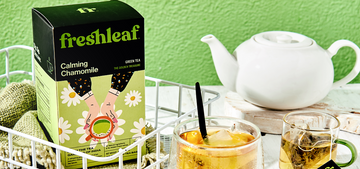Chamomile Iced Tea: A Relaxing and Cooling Drink for Summers
by Lovlesh Saini on Mar 25, 2025
Chamomile Iced Tea: A Refreshing Twist from Freshleaf
If you’re looking for a beverage that’s as soothing as it is invigorating, then welcome to the world of Chamomile Iced Tea by Freshleaf. Well, actually by me, but you know brand integration, right? Well, in today’s post/blog/recipe/ a piece of my heart, I’ll talk about the art and science of crafting this chilled relaxer drink for summer. Now, whether you’re a tea aficionado or a curious beginner, this blog is your ultimate guide to making, enjoying, and even customizing a glass of chilled chamomile tea that sings of summer relaxation with a hint of sophistication, relaxation, and good sleep.
But why Chamomile? Is chamomile tea good for you?
Well, Chamomile has been cherished for centuries, used by ancient Egyptians, Greeks, and countless herbalists for its calming properties and gentle floral aroma. Used in everything from cosmetics to aromatherapy to beverages, calming chamomile has been around for ages, dating back thousands of years, at least to ancient Egyptian times. The daisy-like flowering plant comes from the Asteraceae family of plants (which also includes sunflowers, Echinacea, and marigold) and is most famously known as a relaxing herb.
Even Peter Rabbit’s mother used the herb, sending the mischievous young bunny to bed with a cup of chamomile tea when he returned home after narrowly escaping from Mr. McGregor’s garden.
Where does Chamomile come from? The history of the herb!
The term chamomile comes from the Greek word “Chamomaela” or “ground apple” to describe its refreshing, apple-like scent. In Spain, chamomile has been known for centuries as “mantazilla” or “little apple” for the same reason. Whether used for its fragrance, its relaxing properties, or its flavor profile, chamomile’s history spans many cultures and continents. It's naturally sweet, apple-like flavor makes it perfect not just for a hot cup before bed, but also as an unexpectedly refreshing iced beverage. With Chamomile Iced tea, you get the best of both worlds, a drink that relaxes your mind and cools you down on those sizzling summer afternoons.
Fun fact: Unlike traditional teas made from the Camellia Sinensis plant, chamomile is an herbal tisane. That means it’s completely caffeine-free, making it an excellent option for every member of the family.
Moving further, ancient Egyptians dedicated chamomile to their Gods because they believed it to help cure “the fever”. The Spanish used chamomile as a flavoring agent in sherry making. The Romans sipped chamomile as a healing beverage and used it as incense. English brewers used chamomile flowers throughout the Middle Ages as a bittering agent in beer making. In fact, the bitter hops flowers we associate with beer making today eventually replaced chamomile as a key beer flavoring ingredient. Monks during the Middle Ages cultivated the plant not only for beer but also for use in traditional herbal remedies. They even noticed that planting chamomile near other species of ailing plants would aid in the ailing plant’s recovery. It was later discovered that the plant’s apple-like smell repels insects and other plant pests, which protects the chamomile as well as its neighboring plants.
How is the Chamomile flower grown?
Both German chamomile, Matricaria chamomilla, and Roman chamomile, Chamaemelum nobile, are varieties of chamomile cultivated and used for herbal tea and other herbal applications. German chamomile thrives in Europe and temperate parts of Asia, and it is extensively cultivated in Eastern Europe. German Chamomile is also known as wild chamomile; it is so wild that it grows like a roadside weed in some areas. Roman chamomile, on the other hand, thrives in Central Europe and North America.
Perhaps as a nod to its ancient origins, much of the commercially available chamomile originates in Egypt. But both chamomile varieties are known to be cultivated in other temperate climates around the world, including India, South America, South Africa, and Australia. Depending on where you live, starter plants can usually be found at garden stores for backyard or container herb gardening.
Chamomile flowers usually bloom into little white flowers with yellow centers, like mini daisies. The chamomile flowers sit atop long, thin stems that shoot up anywhere from 6 to 24 inches from the plant’s base. The German chamomile flowers give off a strong, herbal, and sometimes pungent scent. The Roman chamomile flowers are described as having a sweeter, almost fruity scent.
The plant’s flowers and buds are usually what are harvested and dried for chamomile tea. Chamomile flowers are harvested as the flowers open. In Egypt, the flowers are generally by hand or with a tool called a chamomile rake; the flowers bloom over several months and are picked every seven to ten days. By contrast, in Eastern Europe, harvesting machines harvest a field of chamomile flowers just two or three times over the growing season.
The Freshleaf Chamomile Iced Tea Recipe
Ingredients
-
For the Tea:
1 cup (250ml) filtered water
1 Freshleaf’s calming chamomile tea bag
½ teaspoon of natural sweetener (honey, agave, or your preferred choice)
A squeeze of fresh lemon juice (about ½ teaspoon, optional)
3-4 fresh mint leaves
-
For the Ice Cubes (optional, but believe me, oh-so-cool)
½ cup water or additional chamomile tea (for extra flavor)
A few fresh berries (blueberries, raspberries, or sliced strawberries) or a thin slice of lemon
Directions
-
Brew the Chamomile Base: Bring 1 cup of water to a boil. Remove the water from the heat and add your Freshleaf’s calming chamomile tea bag. Let it steep for 2-3 minutes. For a more robust flavor, you can let it steep for a bit longer, but avoid over-steeping to prevent any bitterness.
-
Sweeten and Enhance: While the tea is still warm, stir in your natural sweetener until fully dissolved. If you love a hint of citrus, add a squeeze of fresh lemon juice at this stage.
-
Cool it down: Allow the tea to reach room temperature, then place it in the refrigerator for at least an hour until it’s well chilled.
-
Prepare the Ice Cubes (Optional): For an extra burst of flavor, fill a small ice cube tray with the extra tea or water. Drop in a couple of berries or a thin lemon slice into each compartment. Freeze for at least 4 hours (or overnight) so you have delicious, flavored ice cubes ready to add the spark to your drink.
-
Assemble and Garnish: Fill a serving glass with the berry or citrus ice cubes. Pour your chilled chamomile tea over the cubes. Top with a few fresh mint leaves for a refreshing aroma and a final squeeze of lemon if desired.
-
Sip and Smile: Enjoy your personal glass of chamomile iced tea as a standalone treat or pair it with your favorite light snack. It’s the perfect drink to refresh your body and calm your mind.
Health benefits of this Chamomile Iced Tea
-
Stress Relief: Its natural sedative properties help soothe your mind, ideal for a busy day
-
Digestive Aid: Chamomile is known to ease digestion and help reduce bloating
-
Anti-inflammatory: Enjoy its gentle anti-inflammatory effects, which may aid in soothing minor discomforts.
-
Sleep Support: While perfect for daytime refreshment, a warm cup before bed might help promote a more restful sleep.
Conclusion
There you have it, a comprehensive guide to crafting the perfect single-serving Chamomile Iced Tea that’s educational, insightful, and just a bit cheeky! Whether you’re unwinding after a long day, taking a break during a busy workday, or simply treating yourself, this tea is your ticket to instant calm and delicious refreshment.
So grab your favorite glass, try out this personalized recipe, and let the natural charm of chamomile sweep you away. Cheers to a cooler, calmer day with FreshLeaf!


